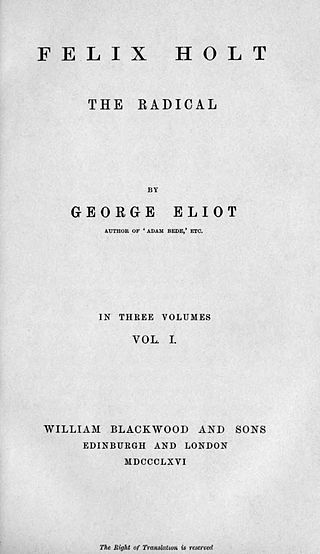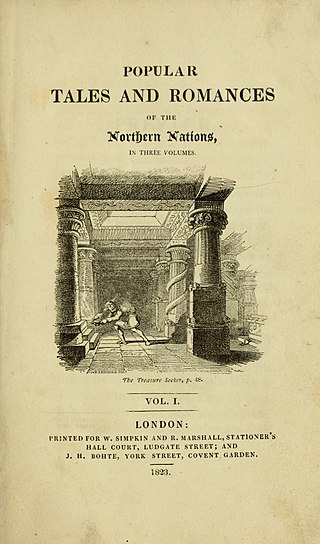
Thomas Penson De Quincey was an English writer, essayist, and literary critic, best known for his Confessions of an English Opium-Eater (1821). Many scholars suggest that in publishing this work De Quincey inaugurated the tradition of addiction literature in the West.

Middlemarch, A Study of Provincial Life is a novel by English author George Eliot, the pen name of Mary Ann Evans. It appeared in eight installments (volumes) in 1871 and 1872. Set in Middlemarch, a fictional English Midlands town, in 1829 to 1832, it follows distinct, intersecting stories with many characters. Issues include the status of women, the nature of marriage, idealism, self-interest, religion, hypocrisy, political reform, and education. Despite comic elements, Middlemarch uses realism to encompass historical events: the 1832 Reform Act, early railways, and the accession of King William IV. It looks at medicine of the time and reactionary views in a settled community facing unwelcome change. Eliot began writing the two pieces that formed the novel in 1869–1870 and completed it in 1871. Initial reviews were mixed, but it is now seen widely as her best work and one of the great English novels.

William Blackwood was a Scottish publisher who founded the firm of William Blackwood and Sons.
John Blackwood FRSE (1818-1879) was a Scottish editor and publisher, sixth son of William Blackwood, founder of the publishing company William Blackwood & Sons. In 1845, John Blackwood became manager and editor of Blackwood’s Edinburgh Magazine after the death of his oldest brother, Alexander, later becoming head of the firm at the death of his brother Robert. Blackwood died in 1879, having managed the company for thirty-four years, the longest of all the Blackwood editors.

The Mill on the Floss is a novel by English author George Eliot, first published in three volumes on 4 April 1860 by William Blackwood and Sons. The first American edition was published by Harper & Brothers, Publishers, New York.

Margaret Oliphant Wilson Oliphant was a Scottish novelist and historical writer, who usually wrote as Mrs. Oliphant. Her fictional works cover "domestic realism, the historical novel and tales of the supernatural".

Adam Bede was the first novel by English author George Eliot, first published in 1859. It was published pseudonymously, even though Evans was a well-published and highly respected scholar of her time. The novel has remained in print ever since and is regularly used in university studies of 19th-century English literature. She described the novel as "a country story full of the breath of cows and scent of hay".

Romola (1862–63) is a historical novel written by English author Mary Ann Evans under the pen name of George Eliot set in the fifteenth century. It is "a deep study of life in the city of Florence from an intellectual, artistic, religious, and social point of view". The story takes place amidst actual historical events during the Italian Renaissance, and includes in its plot several notable figures from Florentine history.
Events from the year 1824 in the United States.

Felix Holt, the Radical (1866) is a social novel written by English author George Eliot about political disputes in a small English town at the time of the First Reform Act of 1832.

Blackwood's Magazine was a British magazine and miscellany printed between 1817 and 1980. It was founded by the publisher William Blackwood and was originally called the Edinburgh Monthly Magazine. The first number appeared in April 1817 under the editorship of Thomas Pringle and James Cleghorn. The journal was unsuccessful and Blackwood fired Pringle and Cleghorn and relaunched the journal as Blackwood's Edinburgh Magazine under his own editorship. The journal eventually adopted the shorter name and from the relaunch often referred to itself as Maga. The title page bore the image of George Buchanan, a 16th-century Scottish historian, religious and political thinker.
The Lifted Veil is a novella by George Eliot, first published anonymously in Blackwood's Magazine in 1859. It was republished in 1879. Quite unlike the realistic fiction for which Eliot is best known, The Lifted Veil explores themes of extrasensory perception, possible life after death, and the power of fate. The story is a significant part of the Victorian tradition of horror fiction, which includes such other examples as Robert Louis Stevenson's Strange Case of Dr. Jekyll and Mr. Hyde (1886), and Bram Stoker's Dracula (1897).
Rev William Lucas Collins was a Church of England priest and essayist.

Rachel Ray is an 1863 novel by Anthony Trollope. It recounts the story of a young woman who is forced to give up her fiancé because of baseless suspicions directed toward him by the members of her community, including her sister and the pastors of the two churches attended by her sister and mother.
Mr. Gilfil's Love Story is a 1920 British silent drama film directed by A. V. Bramble and starring Robert Henderson Bland, Mary Odette and Peter Upcher. It was based on the short story Mr. Gilfil's Love Story from George Eliot's 1857 work Scenes of Clerical Life. A chaplain to an aristocratic British family falls in love with their ward, a young Italian woman, who he marries. Tragedy strikes when she dies only a few months later, leaving him in a state of grief.

This is a bibliography of the works of Anthony Trollope.

Fred Lewis Pattee was an American author and scholar of American literature. As a professor of American literature at the Pennsylvania State University, Pattee wrote the lyrics of the Penn State Alma Mater. Pattee is sometimes labeled the "first Professor of American Literature", a position he held at Penn State from 1895 until 1928.
The Ancient Classics for English Readers series was a collection of 28 volumes of classics of ancient Greek and Latin literature, translated into English with paraphrases and commentaries by leading classical scholars. The series was published from 1870 in Edinburgh and London by William Blackwood and Sons. From 1870 J. B. Lippincott & Co. republished the series in Philadelphia. The founding editor was W. Lucas Collins.

George Buchan was a civil servant who was shipwrecked on his first passage to India as a teenager. Born into an elite family, his career progressed in the Indian Civil Service rising to the rank of Chief Secretary. Following his retirement, he came home to Scotland and had a Christian conversion. After several years as an elder in the Church of Scotland, he left at the Disruption and joined the Free Church of Scotland. He was an author writing about shipwrecks, Madras and about duelling as well as about church-state relations. He also wrote about God's providence illustrated from his own biography. Buchan was also an office bearer for a number of charity organisations.

Popular Tales and Romances of the Northern Nations is an anthology of translated German stories in three volumes, published in 1823.















